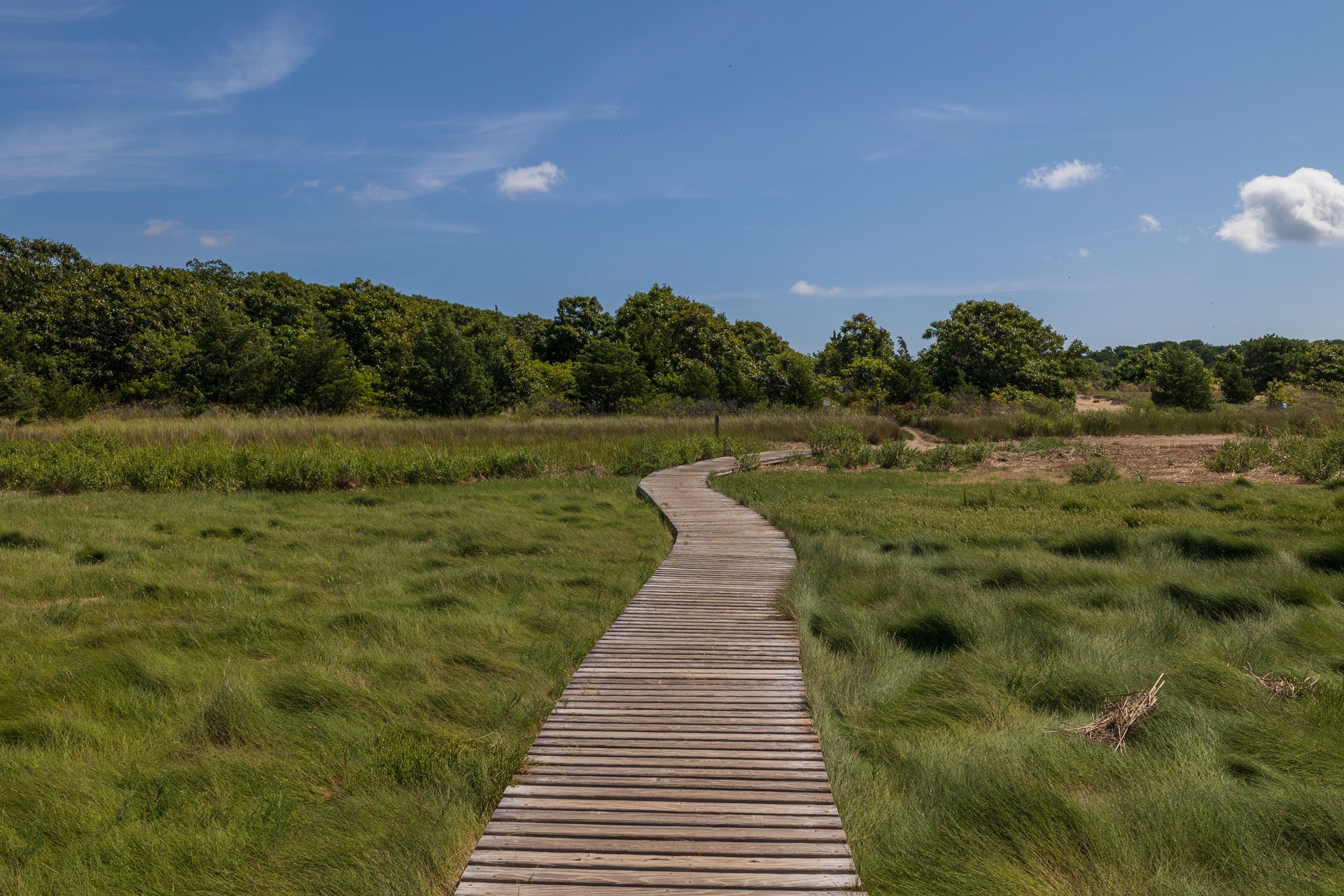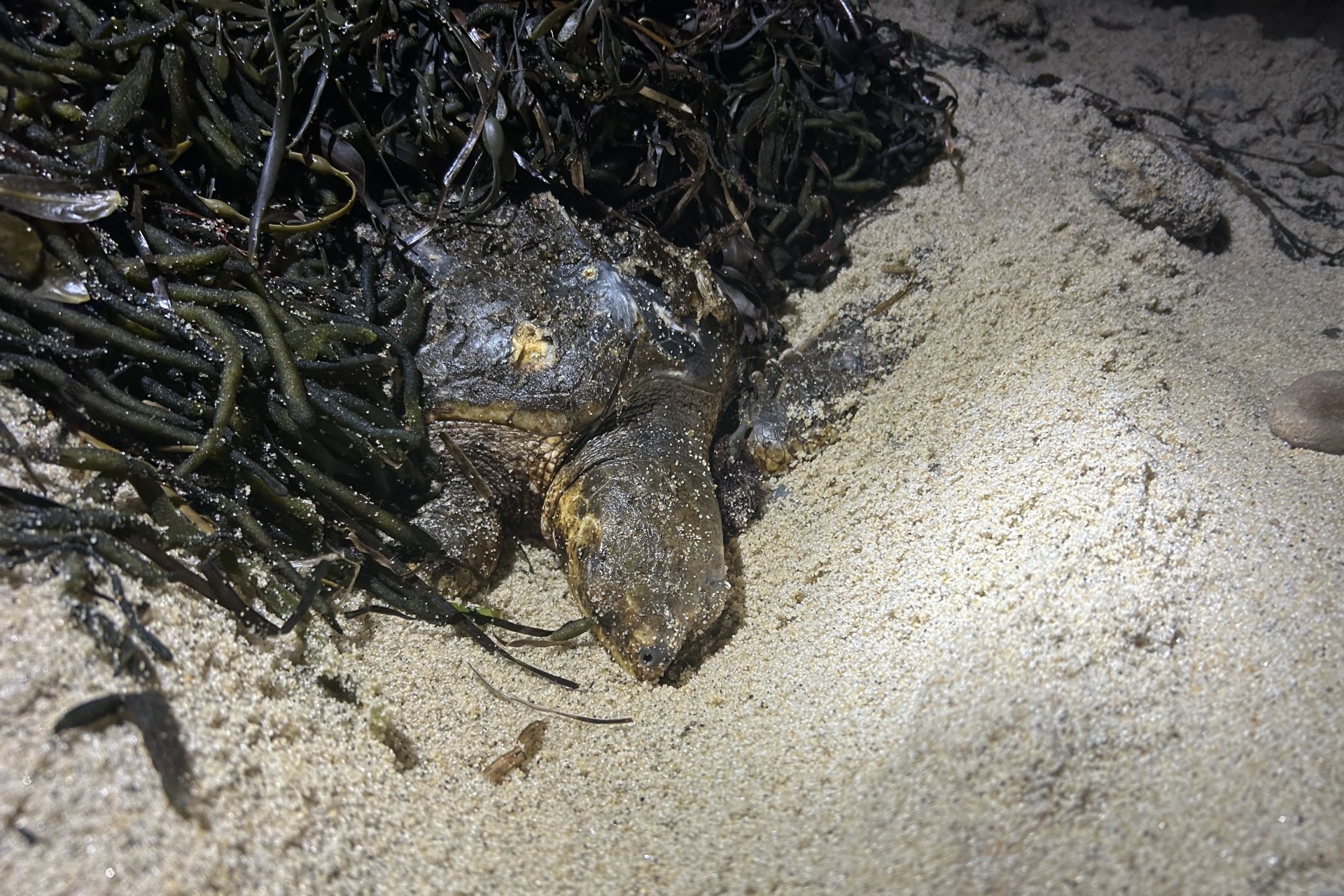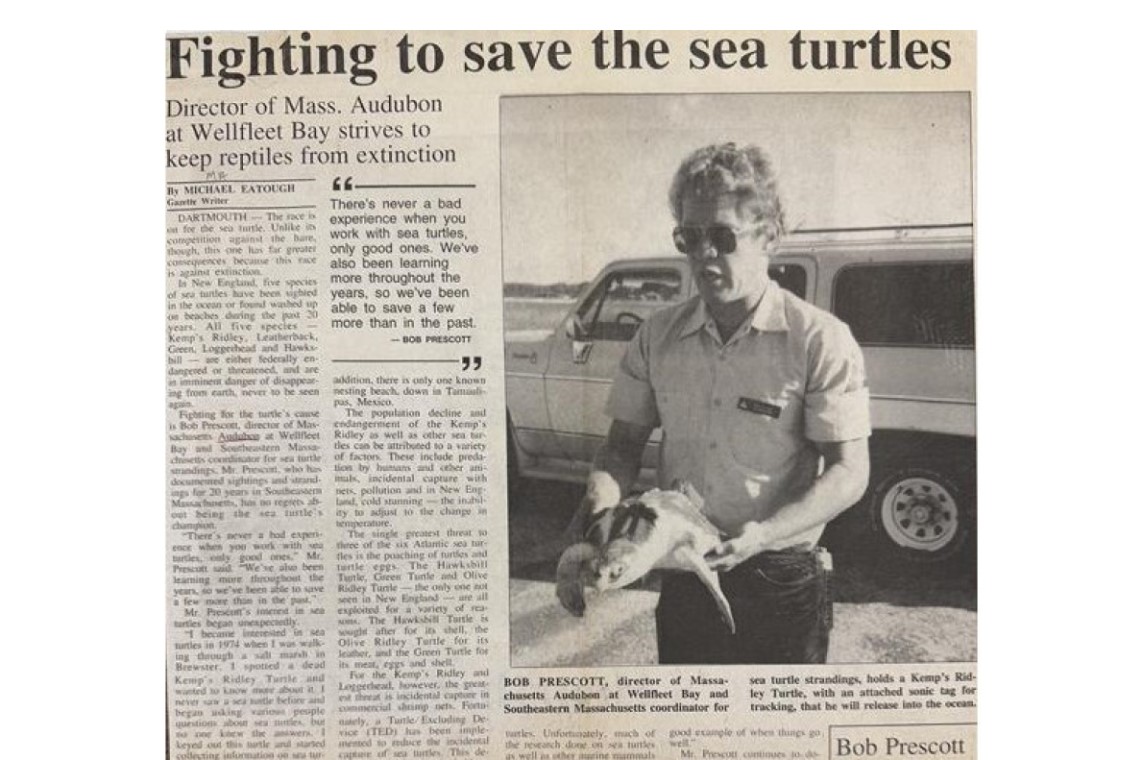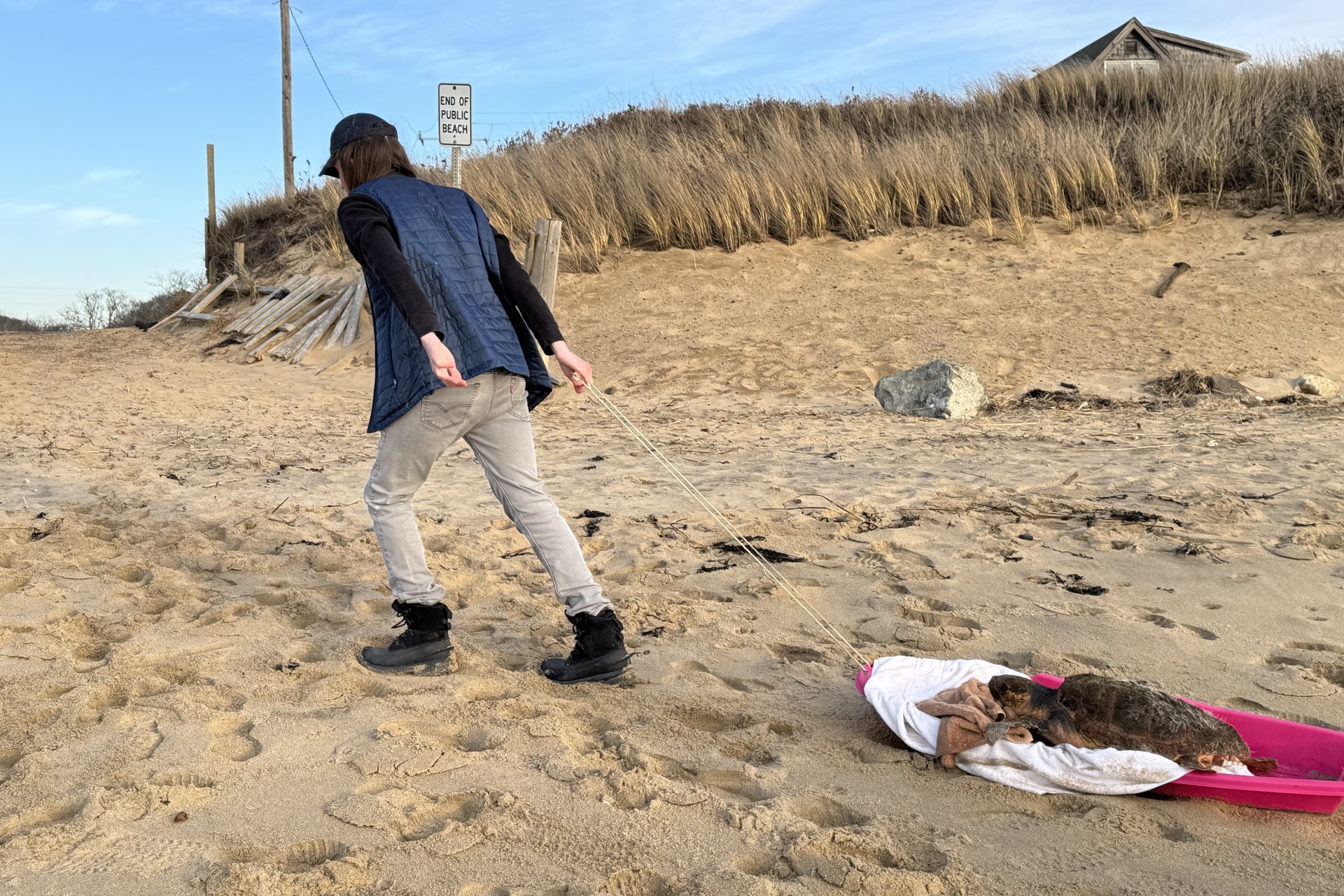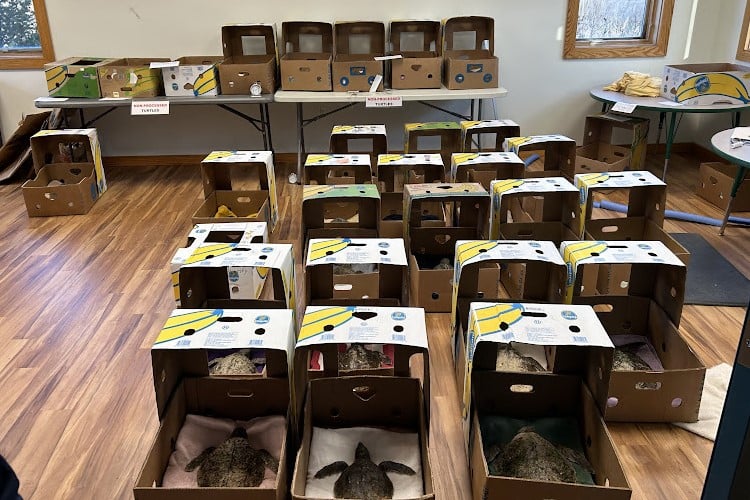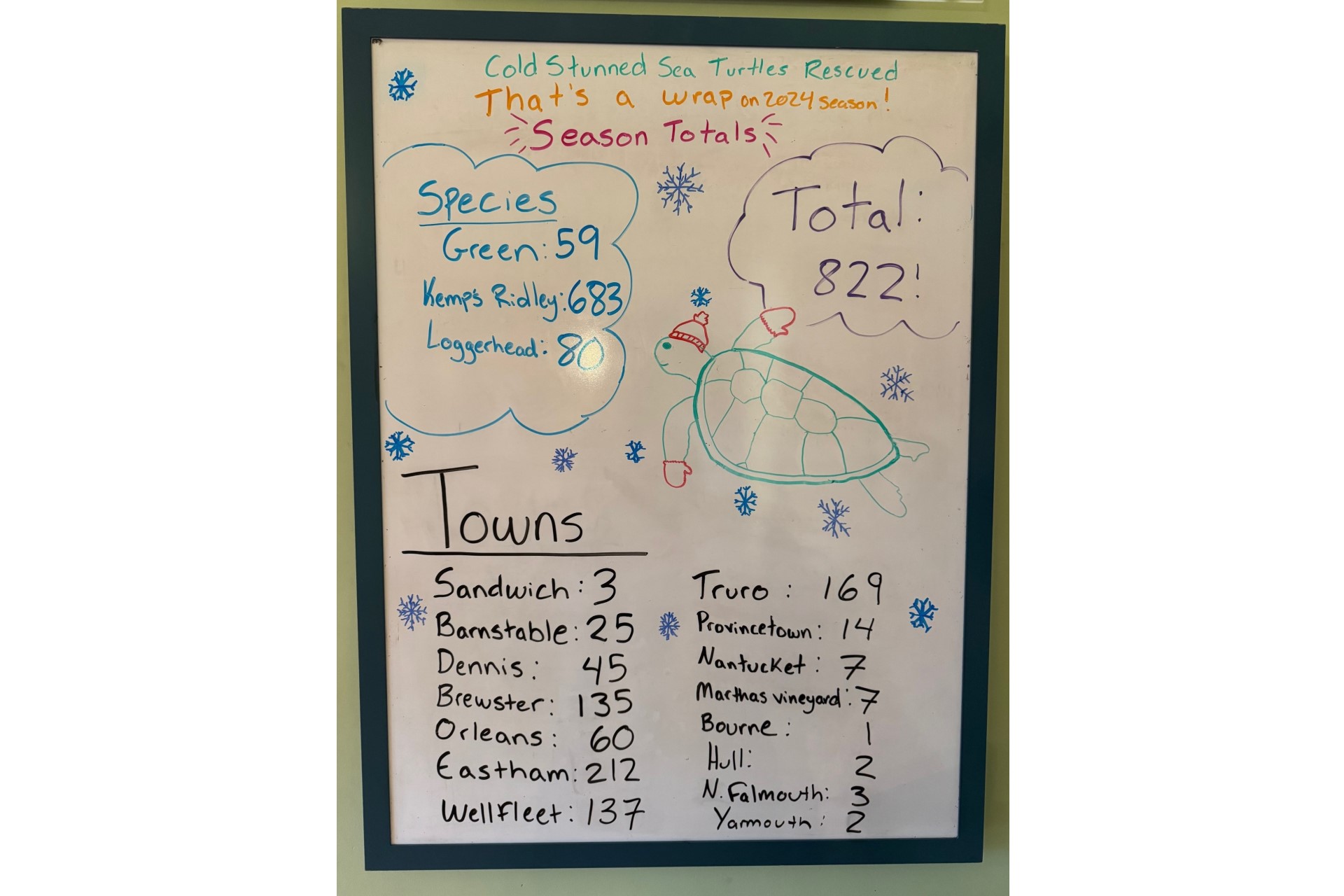Wellfleet Bay News
A 50 Year Journey to Save the Critically Endangered Kemp's Ridley Sea Turtle
February 20, 2025
In the fall of 1974, Bob Prescott, Wellfleet Bay Wildlife Sanctuary Director Emeritus, found his first cold-stunned sea turtle on Cape Cod.
“Walking on that cold Brewster beach, I was absolutely shocked to discover a sea turtle. I had spent much of my life exploring the Cape’s beaches and waters and had never heard of anyone seeing sea turtles in the area. I reached out to every sea turtle scientist, naturalist, and researcher in the United States I could get a hold of trying to understand how it got here. We thought this poor waif was a lonely sea turtle that had lost its way.”
He didn’t know it then, but that cold and windy November day marked the start of an epic journey to save the rarest and most endangered sea turtle in the world—the Kemp’s ridley. As Kemp’s ridleys, along with a small number of Greens and Loggerheads, continued to cold-stun and wash onto the shores of Cape Cod Bay each fall and winter, Bob got to work, learning everything he could about how to help these animals, forging partnerships with veterinarians and aquariums around the country, and recruiting a dedicated team of staff and volunteers to brave the cold in the search for sea turtles clinging to life.
Why Do Sea Turtles Strand on the Beach?
When the Kemp’s ridleys, Greens, and Loggerheads feeding along our coasts in the summer and early fall begin to make their way south to warmer waters, some of these immature sea turtles can become “trapped” by the hooked shape of Cape Cod. As the water cools, the turtles become “cold-stunned”: hypothermic, unable to swim or eat, and eventually stranding on the beach.
A cold-stunned Kemp’s ridley sea turtle stranded on the beach. This turtle is one of hundreds of turtles rescued from Cape Cod Bay Beaches in 2024.
In the 50 years since that first stranded sea turtle was discovered, more than 10,000 cold-stunned sea turtles have been rescued or recovered through Mass Audubon Wellfleet Bay’s Sea Turtle Rescue and Research Program. The vast majority of these turtles have been rehabilitated and released back into the wild, giving renewed hope for the fate of their species.
Local Efforts, Global Impact
When Bob found that first “lost” turtle 50 years ago, the Kemp's ridley was on the brink of extinction.
The majority of Kemp’s ridley sea turtles nest on the northeast coast of Mexico, near the Texas border, returning to the same beach where they were born to nest as adults. After the population of nesting females declined from 40,000 in 1947 to less than a thousand in the 1970s, the United States and Mexico collaborated on an ambitious effort to save these sea turtles by protecting the nesting turtles, their eggs and hatchlings, and establishing a nesting colony of Kemp’s ridleys at Padre Island National Seashore in Texas.
A decade later, new regulations required commercial fisheries to use special devices called “turtle excluders” in their nets to reduce the bycatch of turtles. Slowly but surely, these efforts have helped more turtles survive to adulthood and have increased the number of nesting Kemp’s ridleys to over 20,000 nesting females in 2012. However, sea turtles continue to face challenges, as these numbers still reflect half of where their population stood in the early 20th century.
After hatching, baby sea turtles race for the ocean. Many Kemp’s ridleys stay close to where they hatched while others follow the Gulf Stream up the eastern coast of the United States, including the nutrient rich waters of the northwest Atlantic and the Gulf of Maine.
Bob Prescott is featured in this 1993 newspaper article on cold-stunned sea turtle strandings. Bob remains an integral part of the Sea Turtle Rescue and Research Program.
Climate Change Threatens Sea Turtles Around the Globe
Our work makes a difference, but this is not yet a success story. Climate change plays a role in increasing cold-stunned strandings, which must be factored into current and future efforts. With climate change warming the waters of the North Atlantic, more turtles are traveling farther north to feed. This results in higher numbers that don’t make it south before the temperatures drop. We have seen a drastic increase in strandings in Cape Cod Bay in the last 15 years, but we are not alone; European strandings are on the rise as well. The cold-stunned sea turtle stranding in Massachusetts is now the largest annual event of its kind in the world.
Sea turtle staff member Brian Merrigan responds to a call about a cold-stunned Loggerhead sea turtle, bringing it back to the sanctuary to be processed and temperature-stabilized.
A Chain of Support for Rescued Turtles
When the turtles cold stun in Massachusetts, Mass Audubon, permitted by the U.S. Fish and Wildlife Service, acts as first responders. A dedicated team of staff manage a corps of over 200 trained volunteers who patrol the beaches day and night, often in frigid temperatures.
When found, the turtles go to Wellfleet Bay Wildlife Sanctuary where the team quickly assesses their condition, takes baseline data such as body measurements and weight, and prepares the turtle for rehabilitation. After discovery, recovery, and data gathering, the turtles travel to the New England Aquarium’s Sea Turtle Hospital or the National Marine Life Center, where they are treated for any injuries and illnesses.
Cold-stunned sea turtles in their signature banana boxes in the Mass Audubon Wellfleet Bay triage center. Warming the turtles too quickly can lead to shock or even death, so the processing area and transport vehicles are kept at 55 degrees Fahrenheit.
As these facilities reach capacity, the National Oceanic and Atmospheric Administration (NOAA) identifies other options and coordinates their transport. With rehab facilities located along the east coast and Gulf of Mexico, and even the Midwest, many turtles travel by air with the help of Turtles Fly Too. Upon arrival, they’ll spend weeks or months healing and growing strong enough to be released into the ocean.
Each partner in this complex network does their part to save sea turtles and protect biodiversity.
Recapping the 2024-2025 Turtle Rescue Season
This winter, we recovered 822 sea turtles from Cape Cod Bay beaches—our fifth-largest year on record—including 683 Kemp’s ridleys, 80 Loggerheads, and 59 Green sea turtles. This memorable season included the largest stranding day since 2014, with an incredible 141 cold-stunned turtles recovered in a single day, as well as the discovery of a 123-pound Loggerhead, the heaviest cold-stunned sea turtle found since 2020.
A whiteboard at the Wellfleet Bay Wildlife Sanctuary updates visitors on the cold-stunned sea turtle season.
How You Can Help Save Sea Turtles
If you find a stranded sea turtle on Massachusetts’ beaches or have a sighting of a sea turtle in state waters, please follow these instructions.
Local residents who are familiar with Cape Cod Bay beaches and available throughout November and December can contact [email protected] to learn more about volunteering opportunities and requirements.
In addition, this yearly rescue effort wouldn't be possible without the generosity of our supporters. You have the power to make a difference. Help us save these endangered animals by making a donation today. Every dollar counts.
Stay Connected
Don't miss a beat on all the ways you can get outdoors, celebrate nature, and get involved.



